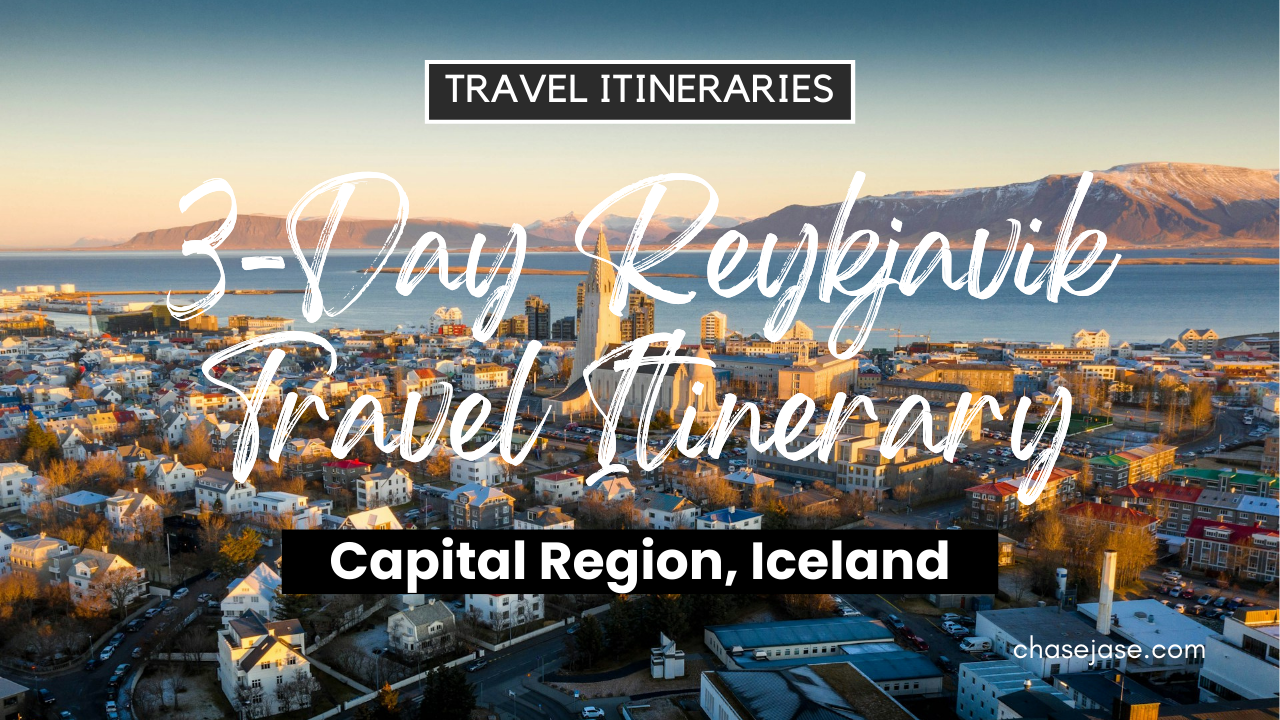3-Day Reykjavik, Iceland Travel Itinerary

Introduction:
Reykjavík is the capital and largest city of Iceland, located on the southwestern coast of the island. This city is known for its colorful houses, creative energy, and strong ties to Icelandic nature and Viking heritage. Reykjavík offers travelers a unique combination of natural wonders and modern culture, from geothermal pools and lava fields to cutting-edge art galleries and cafes. This 3-day itinerary is designed to help visitors experience Reykjavík’s top attractions, local cuisine, and surrounding natural beauty in a well-paced, engaging way.
Places to Visit:
- Hallgrímskirkja Church: This is Reykjavík’s most iconic building, offering panoramic views of the city from its tower.
- Harpa Concert Hall: This modern glass building is both an architectural landmark and a hub for music and cultural events.
- Sun Voyager (Sólfar) Sculpture: This steel sculpture near the waterfront resembles a Viking ship and is a popular photo spot.
- Perlan Museum: This museum features interactive exhibits about Iceland’s glaciers, volcanoes, and auroras, and includes a 360° viewing platform.
- National Museum of Iceland: This museum provides an in-depth look at Iceland’s history, from settlement to the present day.
- Laugavegur Street: Reykjavík’s main shopping and dining street is filled with boutiques, cafes, and local artisan shops.
- Árbær Open Air Museum: This heritage museum displays traditional Icelandic homes and buildings, offering a glimpse into life in past centuries.
- Reykjavík Maritime Museum: Located in the old harbor, this museum explores Iceland’s fishing industry and seafaring history.
- Nauthólsvík Geothermal Beach: This unique beach is heated by geothermal water and offers swimming in warm lagoons even in cold months.
- Reykjavík Old Harbour: This historic area has been transformed into a lively hub of restaurants, whale-watching tours, and sea views.

Sample Itinerary:
Day 1: Exploring Reykjavík’s Culture and Architecture
- 9:00 AM – Start at Hallgrímskirkja Church: Visit the tower for sweeping views of Reykjavík and take photos of the iconic architecture (1 hour).
- 10:00 AM – Walk to the Sun Voyager Sculpture (10-minute walk): Enjoy the ocean breeze and views of Mount Esja across the bay (30 minutes).
- 10:30 AM – Continue to Harpa Concert Hall (10-minute walk): Admire the unique glass structure and explore inside (1 hour).
- 12:00 PM – Lunch at a local café on Laugavegur Street: Try Icelandic lamb soup or fish stew.
- 1:30 PM – Visit the National Museum of Iceland (15-minute walk): Discover the country’s deep historical roots through artifacts and multimedia (1.5 hours).
- 3:30 PM – Explore Laugavegur Street: Shop for local wool, crafts, and grab a coffee at Reykjavik Roasters (1.5 hours).
- 5:00 PM – Dinner at a traditional Icelandic restaurant nearby.
Day 2: Nature, Museums, and Local History
- 9:00 AM – Visit Perlan Museum (10-minute taxi): Explore the Wonders of Iceland exhibit and walk through the ice cave replica (2 hours).
- 11:30 AM – Walk through Öskjuhlíð Hill Forest next to Perlan: Take short trails and enjoy nature (30 minutes).
- 12:30 PM – Lunch at Perlan’s restaurant or nearby.
- 2:00 PM – Head to Árbær Open Air Museum (15-minute taxi): Explore the historic homes and learn about traditional Icelandic life (1.5 hours).
- 4:00 PM – Return to Reykjavík Old Harbour (20-minute taxi): Stroll the area or visit the Maritime Museum (1 hour).
- 5:30 PM – Early dinner at a seafood restaurant in the harbor.

Day 3: Geothermal and Relaxation Experience
- 10:00 AM – Head to Nauthólsvík Geothermal Beach (15-minute taxi): Swim in the geothermal lagoon or relax on the heated sands (1.5 hours).
- 12:00 PM – Lunch at a nearby bistro near the university district.
- 1:30 PM – Optional whale-watching tour from Reykjavík Old Harbour: This 3-hour experience allows you to spot humpback whales, puffins, and porpoises.
- 5:00 PM – Return and enjoy a warm drink at a harbor café.
- 6:30 PM – Final dinner in Reykjavík at an upscale Nordic-fusion restaurant such as Dill or Grillmarkaðurinn.
- 8:30 PM – Optional Northern Lights tour (seasonal): Join a small group tour to see the aurora borealis from a nearby dark-sky location (2–3 hours, available from September to April).
See Itinerary Map (Includes Places to Visit and Accommodations)
Best Time To Go:
The best time to visit Reykjavík depends on the experience you are seeking. June to August is the high season due to warm weather, long daylight hours, and accessible roads for day trips. February to April and September to early April are ideal for seeing the Northern Lights. Travelers should be prepared for sudden weather changes year-round, as Iceland’s climate is unpredictable.
Activities To Do:
- Join a Northern Lights tour: This evening excursion takes travelers out of the city to dark areas with minimal light pollution for the best aurora views.
- Take a whale-watching cruise: Departing from the Old Harbour, this boat trip allows visitors to see humpback whales and puffins in their natural habitat.
- Soak in a geothermal pool: Places like Laugardalslaug offer authentic Icelandic hot water swimming and relaxation.
- Visit a local bakery: Try kleina (Icelandic twisted doughnuts) or skyr (Icelandic yogurt) at a downtown bakery.
- Tour the Golden Circle from Reykjavík: Though outside the city, it’s a popular day trip covering Þingvellir National Park, Geysir, and Gullfoss waterfall.

Accommodations:
- The Reykjavík EDITION: This luxury hotel offers designer interiors, spa services, and views of the harbor.

- Hotel Borg by Keahotels: Located near Austurvöllur Square, this Art Deco hotel provides historic charm and fine dining.

- ION City Hotel: This boutique hotel offers sleek modern design and is located on Laugavegur Street.

- Grandi by Center Hotels: Centrally located, this hotel offers good value with comfortable rooms and breakfast included.

- Fosshotel Reykjavík: Iceland’s largest hotel provides spacious rooms, a beer garden, and easy access to the city center.

- Kex Hostel: This trendy hostel in an old biscuit factory offers dorms and private rooms, plus a lively bar and café.

- Guesthouse Galtafell (Galtafell Apartments): A charming and affordable stay in a historic building with basic comforts and a great location.

Transportation Options:
- Walking: Reykjavík’s downtown is compact and pedestrian-friendly, making walking the best way to explore central attractions.
- City Buses (Strætó): Reykjavík’s public transport network is reliable and covers most areas. Tickets can be purchased via the Klapp app.
- Taxis: Taxis are safe but expensive. Rides can be booked by phone or at taxi stands.
- Car Rentals: Ideal for day trips or exploring outside the city. Roads are well-maintained, but weather can affect driving.
- Airport Transfers: The Flybus and Airport Direct offer direct transportation from Keflavík International Airport to Reykjavík city center.
- Bike Rentals: In summer, bikes are a great way to explore the city paths and coastline.
Tips:
- Book Northern Lights tours in advance: They sell out during peak aurora season (Sept–April).
- Bring waterproof layers: Iceland’s weather can change rapidly, even in summer.
- Credit cards are accepted everywhere: No need to carry much cash.
- Respect geothermal areas and nature rules: Iceland protects its environment carefully.
- Try traditional food, but research first: Dishes like fermented shark can be intense for some visitors.
Reykjavík is a captivating city that balances Nordic charm, creative culture, and natural beauty. This 3-day itinerary provides a thoughtfully planned experience, from historical sights and museums to geothermal beaches and harbor cruises. Visitors will leave with a deeper appreciation for Iceland’s capital and the rich Icelandic identity it represents. Whether chasing Northern Lights or soaking in a hot pool, Reykjavík offers a refreshing and memorable European escape.



